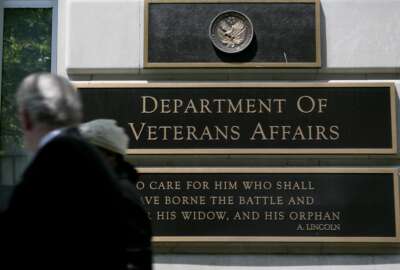

The Veterans Affairs Department is looking to right-size its sprawling network of medical facilities across the country, and is planning to close or overhaul fa...
Best listening experience is on Chrome, Firefox or Safari. Subscribe to Federal Drive’s daily audio interviews on Apple Podcasts or PodcastOne.
The Department of Veterans Affairs is looking to right-size its sprawling network of medical facilities across the country, and is planning to close or overhaul facilities that no longer meet the health care needs of veterans.
The VA on Monday released its recommendations for the Asset and Infrastructure Review (AIR) Commission, which is mandated under the 2018 MISSION Act.
The release of these recommendations to the AIR Commission report kicks off a year-long process of the commission reviewing the recommendations, holding public hearings and submitting its own recommendations to Congress and President Joe Biden by the end of January 2023.
VA Secretary Denis McDonough wrote in the report that these recommendations, if approved, would result in better working conditions for VA employees.
“After years of working in outdated facilities, VA employees would finally be able to work in modern facilities with the modern tools they need to deliver on the mission they so diligently strive to execute every day,” McDonough wrote.
The agency, under this plan, is looking to close approximately three dozen VA medical centers (VAMCs), but would replace about half of them with new construction. The VA would permanently close the other half, and would shift veteran care to local VA inpatient and outpatient facilities.
Meanwhile, the VA proposes building VAMCs in new areas. All told, McDonough last week said the plan calls for a net reduction of three VAMCs, bringing the total from 171 to 168.
Last week, Biden announced that he expects to nominate eight members to the AIR Commission. The nominations require Senate confirmation.
Biden has until Feb. 15, 2023 to approve the AIR Commission’s final recommendations. If he doesn’t submit his approval to Congress before March 30, 2023, the process for modernizing and realigning VA’s facilities under the MISSION Act ends.
While the total number of outpatient points of care would also decrease under this plan, the VA states the relocation and expansion of facilities and services will increase veterans’ overall access to VA care.
The recommendations call for a “significant investment in infrastructure” to provide primary care, specialty care and outpatient mental health care in modern facilities.
The VA recommends nearly doubling the number of its health care centers (HCCs) that provide primary care, mental health care, outpatient specialty services, as well as ambulatory surgery or invasive procedures. The number of HCCs would increase from 16 to 30.
The plan would also increase the number of sites that provide inpatient medical services from 134 to 140, and would bring inpatient care within an hour’s drive for hundreds of thousands of additional veterans.
The multi-specialty community-based outpatient clinics (MS BOCs) that provide primary care and mental health care services, as well as specialty care services, would go from 248 to 388, an increase of 56%.
The number of community-based outpatient clinics (CBOCs) that offer primary care on-site, as well as mental health services in-person or via telehealth appointments, would go from 555 to 469, a 15% decrease.
The number of other outpatient services (OOS) sites that provide social services, homelessness outreach services and some clinical care would shrink from 255 to 169, a decrease of 34%.
The recommendations also look at modernizing the VA’s health care facilities to keep up with emerging trends in patient care.
The average age of a VA hospital is nearly 60 years old, while a private sector hospital is only 8.5 years old on average.
“These facilities were not designed to meet modern health are standards, which limits VA’s agility and ability to meet evolving veteran care needs, and basic environment of care expectations,” the report states.
House VA Committee Ranking Member Mike Bost (R-Ill.) said in a statement that “for far too long, VA’s infrastructure has been slowly crumbling,” and that veterans deserve a better quality of care.
“I look forward to the work that the AIR Commission will do in the coming months to ensure the recommendations VA released today stand up to scrutiny and fulfill the promise AIR holds for veterans nationwide. There are many milestones and hard decisions ahead but retaining the status quo is not an option,” Bost said.
Senate Veterans’ Affairs Committee Chairman Jon Tester (D-Mont.) said he would “fight tooth and nail against any proposals that blindly look to reduce access to VA care or put our veterans at a disadvantage.”
“As I’ve said in the past, any effort to kneecap our veterans’ health care is a non-starter for me,” Tester said.
American Federation of Government Employees President Everett Kelley said in a statement last week that the VA’s plans would “dismantle large segments of the VA health care system.”
The report states that aging infrastructure also affects the VA workforce, and doesn’t provide them with the space or tools they need to best meet the needs of veterans.
The report focuses the future of VA health care on four objectives:
An integrated planning team led the market assessments that served as a foundation for the AIR Commission recommendations.
That team was co-chaired by the VHA chief medical officer, its chief strategy officer, and the assistant under secretary for health for community care.
The recommendations focus on broadly serving a veteran population that’s shrinking in size but growing in diversity.
“The decline in enrollee population creates challenges for VA in maintaining sufficient patient volume to operate specialty services in certain areas while maintaining patient safety and provider competencies. VA must be able to adapt to this decreasing veteran population, innovating to enhance access to high-quality care,” the report states.
The VA’s strategy also focuses on shifting resources to make care more accessible based on where veterans live.
The report notes that 50% of the veteran population lives in just 10 states. The veteran population is also growing with the South and Southwest, but shrinking in the Northeast.
Meanwhile, the VA sees growing demand for outpatient services and long-term support services, including nursing home care.
The VA currently operates 171 medical facilities and more than a thousand outpatient sites of care.
In some markets, the VA is struggling to recruit and retain employees, which can result in increased wait times for veterans seeking care.
The report notes the COVID-19 pandemic broadly increased attrition for health care workers in and out of the VA system, and that across all workforce categories, the VA competes with private-sector employers for doctors and nurses.
“In the face of a limited supply of providers, VA is often unable to compete with private-sector salaries, particularly for specialist physicians,” the report states.
The report also asks Congress to pass legislation that would help bolster the agency’s health care workforce. VA’s requests include:
McDonough said the VA built many of its hospitals when inpatient care was the primary means of care for veterans, but health care trends have allowed many veterans receiving care to recover at home.
“Simply put, health care has evolved, and these recommendations will help VA evolve with it,” McDonough said.
The VA’s recommendations call for building new facilities to support care for women veterans, while also increasing capacity to support telehealth.
Women veterans are one of the fastest-growing segments of the veteran population, and is expected to increase by 32.5% between fiscal years 2019 and 2029.
Meanwhile, VA has increased access to virtual health services by over 1,700% in response to the COVID-19 pandemic.
The report finds that veterans with chronic health conditions, including cancer, chronic obstructive pulmonary disease (COPD) and diabetes are more likely to rely on VA medical care.
The VA also specializes in care for combat-related conditions, including Post-Traumatic Stress Disorder (PTSD), amputation, traumatic brain injuries, visual impairment, and severe burns.
The VA also offers mental health and suicide prevention programs.
“As the veteran population ages and continues to have unique health needs, veteran enrollees will require more health care services, including long term care and rehabilitative care,” the report states.
The VA is asking for authority from Congress to allow the agency to exchange VA property for other property or in-kind considerations.
The agency is also looking for the ability to construct and renovate shared facilities, sell and lease back facilities and collaborate with the Defense Department to plan, design, construct or lease joint VA-DoD facilities.
Copyright © 2024 Federal News Network. All rights reserved. This website is not intended for users located within the European Economic Area.
Jory Heckman is a reporter at Federal News Network covering U.S. Postal Service, IRS, big data and technology issues.
Follow @jheckmanWFED



